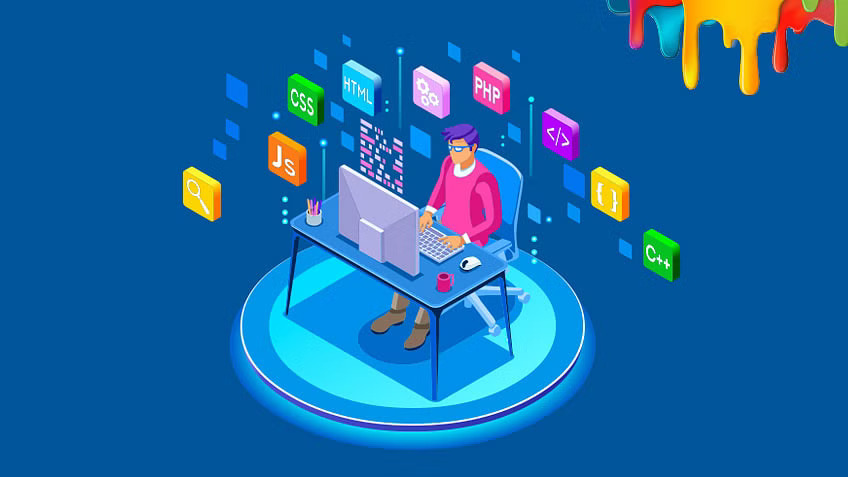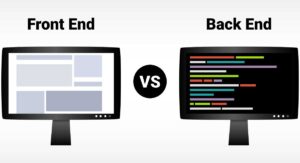Software, applications, and website developers are in high demand today. Users want more sites to visit, apps for their smartphones, and software to run on their laptops and tablets. It’s the digital age, and everyone’s invited!
This article focuses on full stack developers, specifically full stack developer skills. First, we will explore full stack web development, the role of the full stack developer and why they’re needed, the skills a full stack developer needs, the future of full stack development, and the job market picture. Then we’ll show you how to acquire those valuable full stack development skills.
But before we let you in on the skills required for a full stack developer, let’s figure out what full stack development means.
What is Full Stack Development?
Websites are composed of two components: the front-end and the back-end. The back-end, also called server-side, includes the behind-the-scenes elements necessary to run a website or application, including APIs, databases, back-end logic, and servers. Back-end developers are responsible for building and maintaining these components.
The front-end, also called the client-side, makes up everything the user sees or interacts with, like the user interface (UI) and graphical elements (e.g., fonts, video, images). Using a combination of design, programming, and technology, front-end developers ensure visitors can easily interact with the webpage or use the application.
Both the front-end and back-end merge to create a full stack. A tech stack consists of an operating system, a database, a server, and other essential tools such as frameworks, libraries, environments, etc. When several tech stacks are layered and run together, they form a full stack.
Full stack development covers all the aspects of web or app development. The full stack developer skill set enables the developer to move easily between front and back-end development, allowing them to build, maintain, and improve the server-side’s databases, operating systems, libraries, and frameworks, while also grasping the web or mobile application’s user experience (UX) design needs.
Also Read: What Does a Coder Do?
What is a Full Stack Developer, and What Do They Do?
Building off the above definition of full stack development, we see that a full stack developer is a professional who does it all; they can develop and maintain the server-side of a website and build the landing page and user interface for the client-side. Full stack developers have coding skills to cover every aspect of the design project. They do it all.
So, a full stack developer is an IT expert equally skilled in front-end and back-end development. They are familiar with each layer of tech stacks that go into making a software app or web page. They understand how each layer works and can manipulate all the back-end components.
Here is a sample of full stack developer duties. Depending on the organization, a full stack developer could have some or all of these responsibilities.
- Test changes made to previously created programs
- Manage the entire life cycle of the application or software, from the initial conception to launch
- Consult with clients
- Develop software prototypes
- Design applications
- Write code for back-end operations
- Write and optimize code for front-end operations
- Test the code to meet clients’ expectations
- Upgrade and fine-tune software and applications after their deployment
- Gather feedback for the site managers throughout the entire development process
- Oversee front-end architecture and back-end programming
- Perform cross-platform optimization for various digital mediums (desktop, mobile, etc.)
- Facilitate collaborative planning in tandem with other departments
- Troubleshoot and resolve web application issues
- Perform the duties of a manager for the broader development team, even if they aren’t a manager per se
Before we concentrate on full stack developer skills, let’s pause and make an important distinction.
What’s the Difference Between a Full Stack Developer and a Software Engineer?
The IT world has many roles that overlap and plenty of terms used interchangeably, for better or worse. Some people conflate the roles of full stack developers and software engineers when they are two distinctly different specializations.
We can spotlight the differences between the two careers in four distinct areas.
- Tasks. Full stack developers typically carry out design and implementation tasks throughout the development project’s life. Software engineers usually do one or the other—not both.
- Specializations. Full stack developers usually have experience in many domains like data warehousing, business intelligence (BI), and information governance (IG). Software engineers, on the other hand, commonly specialize in one domain.
- Programming languages. Full stack developers must understand programming languages like SQL for database management, HTML or CSS for front-end systems, and Python or JavaScript for back-end systems. Software engineers, by comparison, should be proficient in programming languages like C++, C, and Java, so they have the flexibility to work with a variety of software applications.
- Development stages. Full stack developers are responsible for building an application, including user interface design, code writing, logic design, and testing. On the other hand, software engineers focus on designing system architectures using either back-end or front-end development.
Additionally, although both positions require specialized technical skills, coding skills, and well-developed soft skills, full stack developers typically need more project management skills and greater access to the entire program’s resources.
A Look at the Full Stack Developer’s Hard Skills
It’s best to split the hard skills into front-end, back-end, and general skill categories when looking at the full stack developer skill set. This way, we cover every stage of development. Here is the skill list, with a brief description of each.
Front-end Skills
- HTML. The Hypertext Markup Language determines the structure of the webpage.
- jQuery. jQuery is a JavaScript library that simplifies actions like document traversing, HTML event handling, and Ajax animation.
- CSS. Cascading Style Sheets determine the look and feel of the website.
- ReactJS. ReactJS is an open-source front-end JavaScript library used for building user interfaces.
- AJAX. Ajax enables web applications to send and receive data from servers asynchronously.
Back-end Skills
- Python. Python is a popular programming language usually used for automation, building websites and applications, and conducting data analysis.
- Node.js. Node.js is a platform where back-end developers run JavaScript code before it deploys to a web browser.
- SQL. SQL is a programming language that developers use to extract and organize data in relational data management systems.
- Ruby on Rails. Ruby on Rails is a robust framework and programming language typically used to build social platforms, online stores, and software as a service (SaaS).
- Flask. Flask is a Python web framework that gives developers the libraries, tools, and technologies required to build web applications.
General Skills
- REST. Representational State Transfer serves as a translator between the front-end and back-end. This skill is one of the most vital full stack developer skills required.
- Web Architecture. Full stack developers need to understand web architecture to build server-side structures that meet client-side needs.
- Design fundamentals. Since full stack developers need to work with user interfaces and back-end architecture, they need to understand how users interact with apps and websites.
- HTTP. HyperText Transfer Protocol is a communication protocol that powers web interactions (e.g., loading webpages, streaming video, and other communication between web browsers and servers).
- Database storage. Efficient back-end database storage allows websites and apps to quickly and effectively retrieve needed information.
- NPM. NPM is software used to manage JavaScript package dependencies.
- Git and GitHub. Git tracks file set changes, and GitHub is a web-based interface that lets multiple people make changes to a file simultaneously.
The Soft Skills for Full Stack Developers
There’s more to full stack developer skills than technical know-how. A good full stack developer has a strong command of a diverse set of soft skills, such as:
- Communication
- Multi-Tasking
- Time Management
- Inquisitiveness
- Teamwork
- Effective Leadership
- Patience
- Creativity
- Attention to Detail
Why Does Anyone Need a Full Stack Developer?
Organizations need professionals with a complete set of coding skills to handle any design task that arises, quickly shifting from front to back-end development as required. Here are three other reasons why full stack developers are great.
- They help the organization keep every part of the system running smoothly
- They offer help and support to everyone on the team and significantly reduce team communication times and technical costs
- They reduce the company’s personnel, infrastructure, and operational costs
What Does the Job Market and Salaries Look Like for Full Stack Developers?
As websites and apps get increasingly complex, organizations need professionals that can handle any aspect of the design and project lifecycle. While it certainly doesn’t mean that full stack developers will be a one-person show in web development, it’s to a company’s advantage to have people in IT that can handle any design task.
The U.S. Bureau of Labor Statistics justifies this rosy outlook, reporting that overall employment for digital designers and web developers is projected to grow 23 percent between 2021 and 2031. So it’s fair to infer from this data that full stack developers will have plenty of job opportunities.
Indeed.com reports that full stack developers in the United States potentially earn an average of $119,828 per year, with a high of $191,793.
Read More: What Does a Full Stack Web Developer Salary Look Like?
How You Can Become a Full Stack Developer
Suppose you’re looking to begin a new career in web and app design, or you’re a front or back-end developer who wants to acquire a complete set full stack developer skills. In either case, you should consider joining this full stack developer certificate program.
This comprehensive online course will help you gain the knowledge and practical experience you will need for a career in full stack software development in nine months. You will learn advanced coding skills and master front- and back-end software development via hands-on projects while building a Git portfolio from the ground up.
Topics covered in the course include HTML5 and CSS, Java, JavaScript ES6, Hibernate and JPA, SOAP and REST, DevOps, AWS,and much more.
You might also like to read:
Top Data Scientist Skills You Must Have
How To Get Into Cybersecurity: A Complete Guide
A DevOps Engineer Job Description for Aspiring Professionals






